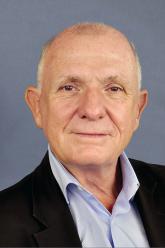Conference Coverage

VIDEO: Beware of over-relying on MRI findings in axSpA
SAN DIEGO – New studies offer insight into specificity of the scans.

REPORTING FROM ACR 2017
Patients with nonradiographic axial spondyloarthritis (nr-axSpA) who enter remission on adalimumab are likely to relapse if the medication is withdrawn – and many won’t attain remission again, even if the drug is restarted.
However, the findings of the ABILITY-3 trial do offer an intriguing potential, Robert Landewé, MD, PhD, said at the annual meeting of the American College of Rheumatology. About 30% of the study group did maintain remission after adalimumab (Humira) withdrawal, suggesting that at least a portion of these patients can stay in good clinical shape off TNF inhibition.
“The problem is, we just don’t know who those patients are,” said Dr. Landewé of the University of Amsterdam. “We need better predictors to help us identify this population, and we just don’t have them right now.”ABILITY-3 is the successor to ABILITY-1, the 2012 placebo-controlled study that established adalimumab as an effective treatment for nr-axSpA. Adalimumab is approved in the United States for the treatment of ankylosing spondylitis (radiographic axSpA), but not for nr-axSpA.
ABILITY-3 assessed the impact of withdrawing adalimumab from nr-axSpA patients who had attained remission on the medication. It enrolled 673 adults with active disease at baseline and an inadequate response to at least two nonsteroidal anti-inflammatory drugs.
The study commenced with open-label adalimumab at 40 mg every other week for 28 weeks. At that point, the 305 patients who had attained disease remission were randomized to either continued adalimumab at the same dose and schedule or to placebo. Randomized treatment continued for 40 more weeks. Any patient who experienced a flare resumed the drug as rescue therapy. The investigators calculated the number of patients with a disease flare at week 68 as the primary endpoint. The study also examined a number of secondary endpoints, including response measures, time to flare, functional status, quality of life, and remission.
At baseline, patients were a mean of 35 years old, with a mean disease duration of about 7 years. Most (88%) were HLA-B27 positive, and about 60% had elevated C-reactive protein levels.
At 68 weeks, patients who discontinued adalimumab were 77% more likely to have experienced a disease flare than were those who stayed on the drug (83% vs. 57% or 70% vs. 47% with nonresponder imputation; relative risk, 1.77). A time-to-flare analysis found a significant 67% reduction in the risk of flare among those continuing to take adalimumab.
While those who experienced a disease flare were allowed to resume adalimumab, it appeared to be far less effective at that point. After 12 weeks of rescue therapy, only 57% had regained remission, leaving 43% with persistent active disease.
Nearly all of the secondary endpoints were in favor of continuing therapy, Dr. Landewé said, including the Ankylosing Spondyloarthritis Disease Activity Score-inactive disease (ASDAS-ID), ASDAS-major improvement, ASDAS-clinically important improvement; the Assessment in Spondyloarthritis International Society (ASAS) 20% and 40% rates; the ASAS 5/6 and ASAS-partial response rates; the Bath Ankylosing Spondylitis Disease Activity Index 50; and the Bath Ankylosing Spondylitis Functional Index. Only health-related quality of life as measured by the Health Assessment Questionnaire for the Spondyloarthropathies did not significantly improve to a greater extent among those staying on adalimumab.
There were no new or concerning safety signals, Dr. Landewé said. In the placebo-controlled period, there were 10 serious adverse events in the placebo group and 1 – a case of ureterolithiasis – in the adalimumab group. There was one malignancy, which occurred in the placebo group. No patient died during the study.
“These results support the continuation of adalimumab therapy after achieving a sustained remission,” Dr. Landewé said. “But it will be an important research goal to identify predictors for the population in whom treatment may be safely discontinued.”
AbbVie sponsored the study. Dr. Landewé reported relationships with numerous pharmaceutical companies, including AbbVie.

SAN DIEGO – New studies offer insight into specificity of the scans.

The net percentage of patients who progressed was 5%, calculated as those who went from nonradiographic axSpA to radiographic axSpA minus those...
